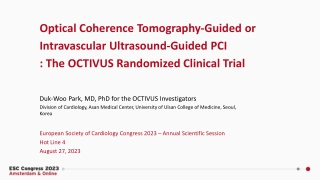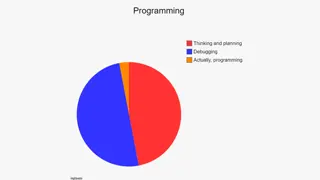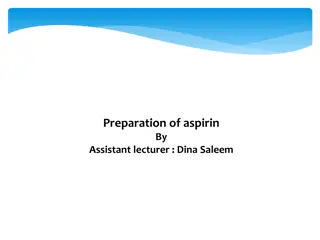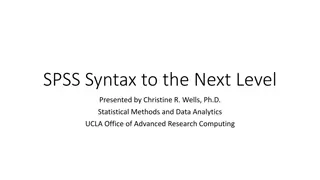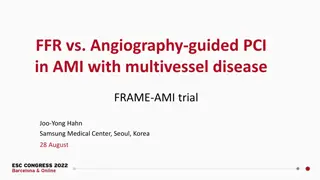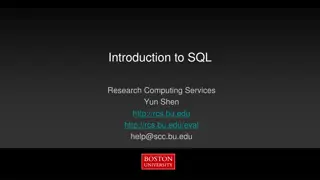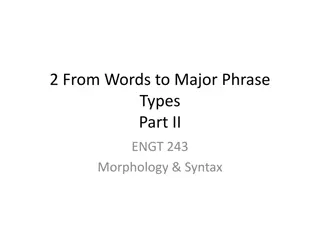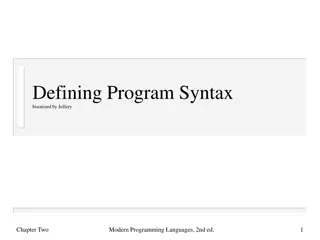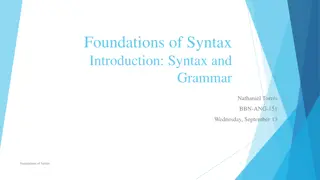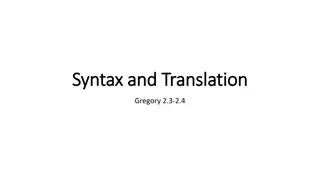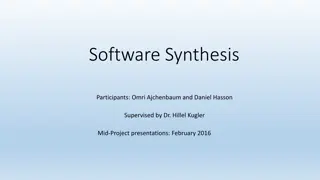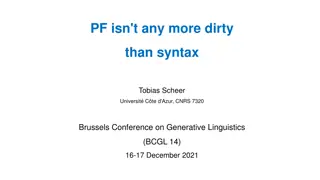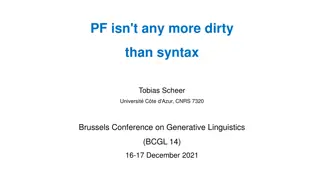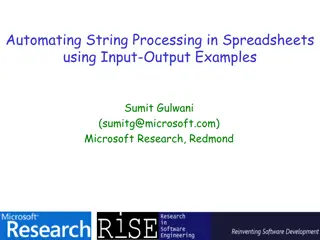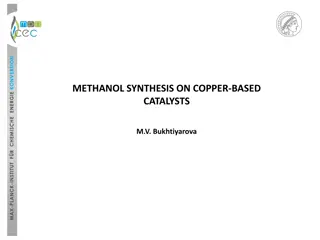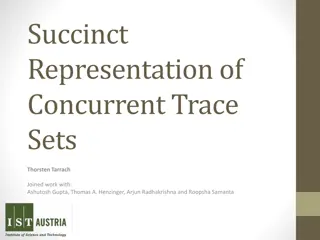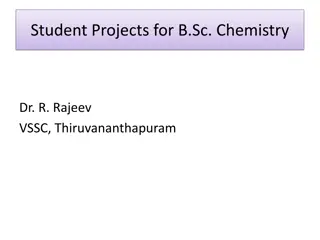Understanding Syntax-Guided Program Synthesis and its Applications
Syntax-guided program synthesis involves finding a program that meets syntactic and logical constraints. It has various applications such as programming by examples, automatic program repair, and cryptographic circuit synthesis. Examples like FlashFill demonstrate the power of programming by examples in tools like Excel.
- Program Synthesis
- Syntax-Guided
- Programming by Examples
- Automated Program Repair
- Cryptographic Circuits
Download Presentation

Please find below an Image/Link to download the presentation.
The content on the website is provided AS IS for your information and personal use only. It may not be sold, licensed, or shared on other websites without obtaining consent from the author. Download presentation by click this link. If you encounter any issues during the download, it is possible that the publisher has removed the file from their server.
E N D
Presentation Transcript
Syntax-Guided Synthesis Rajeev Alur University of Pennsylvania 1
Program Verification Program P Specification S Verifier Proof of correctness or Witness of a bug 2
Classical Program Synthesis Specification S High Level WHAT Synthesizer Program P Low Level HOW 3
Syntax-Guided Synthesis www.sygus.org Syntactic restrictions R on the space of programs Specification S given by logical constraints Synthesizer Program P 4
Outline Motivating Examples Formalization of SyGuS Solving SyGuS SyGuS Competition and Conclusions 5
Syntax-Guided Program Synthesis www.sygus.org Find a program snippet P such that 1. P is in a set E of programs (syntactic constraint) 2. P satisfies logical specification (semantic constraint) Core computational problem with many applications Programming by examples Automatic program repair Program superoptimization Template-guided invariant generation Autograding for programming assignments Synthesis of FSA-attack-resilient cryptographic circuits 6
Programming By Examples Find a program P for bit-vector transformation such that 1. P is constructed from standard bit-vector operations |, &, ~, +, -, <<, >>, 0, 1, 2. P is consistent with the following input-output examples 00101 00100 01010 01000 10110 10000 Resets rightmost substring of contiguous 1 s to 0 s Desired solution: x & ( 1 + (x | (x-1) ) 7
FlashFill: Programming by Examples Ref: Gulwani (POPL 2011) Input (425)-706-7709 510.220.5586 1 425 235 7654 425 745-8139 Output 425-706-7709 510-220-5586 425-235-7654 425-745-8139 Wired: Excel is now a lot easier for people who aren t spreadsheet- and chart-making pros. The application s new Flash Fill feature recognizes patterns, and will offer auto-complete options for your data. For example, if you have a column of first names and a column of last names, and want to create a new column of initials, you ll only need to type in the first few boxes before Excel recognizes what you re doing and lets you press Enter to complete the rest of the column. 8
Superoptimizing Compiler Given a program P, find a shorter equivalent program P multiply (x[1,n], y[1,n]) { x1 = x[1,n/2]; x2 = x[n/2+1, n]; y1 = y[1, n/2]; y2 = y[n/2+1, n]; a = x1 * y1; b = shift( x1 * y2, n/2); c = shift( x2 * y1, n/2); d = shift( x2 * y2, n); return ( a + b + c + d) } Replace with equivalent code with only 3 multiplications 9
Side Channel Attacks on Cryptographic Circuits PPRM1 AES S-box implementation [Morioka & Satoh, in CHES 2002] 1. 2. The only non-linear function in Advanced Encryption Standard algorithm Vulnerable to Fault Sensitivity Analysis attack 10
Side Channel Attacks on Cryptographic Circuits Time at which O0 changes is different when In2=0 vs In2=1 Consequence: Timing-based attack can reveal secret input In2 11
Countermeasure to Attack FSA attack resilient ckt: All input-to-output paths have same delays Manually hand-crafted solution [Schaumont et al, DATE 2014] Verification problem: Is attack resilient ckt equivalent to original? 12
Synthesis of Attack Countermeasures Given a ckt C, automatically synthesize a ckt C such that 1. C is functionally equivalent to C [sematic constraint] 2. All input-to-output paths in C have same length [syntactic constraint] Existing EDA tools cannot handle this synthesis problem 13
Autograder: Feedback on Programming Homeworks Singh et al (PLDI 2013) Student Solution P + Reference Solution R + Error Model Find min no of edits to P so as to make it equivalent to R 14
Automatic Invariant Generation SelectionSort(int A[],n) { i := 0; while(i < n 1) { v := i; j := i + 1; while (j < n) { if (A[j]<A[v]) v := j ; j++; } swap(A[i], A[v]); i++; } return A; } Invariant: ? Invariant: ? post: k : 0 k<n A[k] A[k + 1] 15
Template-based Automatic Invariant Generation SelectionSort(int A[],n) { i :=0; while(i < n 1) { v := i; j := i + 1; while (j < n) { if (A[j]<A[v]) v := j ; j++; } swap(A[i], A[v]); i++; } return A; } Invariant: k1,k2. ? ? Invariant: ? ? ( k1,k2. ? ?) ( k. ? ?) Constraint solver post: k : 0 k<n A[k] A[k + 1] 16
Template-based Automatic Invariant Generation SelectionSort(int A[],n) { i :=0; while(i < n 1) { v := i; j := i + 1; while (j < n) { if (A[j]<A[v]) v := j ; j++; } swap(A[i], A[v]); i++; } return A; } Invariant: k1,k2. 0 k1<k2<n k1<i A[k1] A[k2] Invariant: i<j i v<n ( k1,k2. 0 k1<k2<n k1<i A[k1] A[k2]) ( k. i1 k<j k 0 A[v] A[k]) post: k : 0 k<n A[k] A[k + 1] 17
Syntax-Guided Program Synthesis Find a program snippet P such that 1. P is in a set E of programs (syntactic constraint) 2. P satisfies logical specification (semantic constraint) Core computational problem with many applications Programming by examples Automatic program repair Program superoptimization Template-guided invariant generation Autograding for programming assignments Synthesis of FSA-attack-resilient cryptographic circuits Can we formalize and standardize this computational problem? Inspiration: Success of SMT solvers in formal verification 18
SMT: Satisfiability Modulo Theories Computational problem: Find a satisfying assignment to a formula Boolean + Int types, logical connectives, arithmetic operators Bit-vectors + bit-manipulation operations in C Boolean + Int types, logical/arithmetic ops + Uninterpreted functs Modulo Theory : Interpretation for symbols is fixed Can use specialized algorithms (e.g. for arithmetic constraints) Little Engines of Proof SAT; Linear arithmetic; Congruence closure 19
SMT Success Story Spec# CBMC SAGE VCC SMT-LIB Standardized Interchange Format (smt-lib.org) Problem classification + Benchmark repositories LIA, LIA_UF, LRA, QF_LIA, + Annual Competition (smt-competition.org) Yices MathSAT5 Z3 CVC4 20
Syntax-Guided Synthesis (SyGuS) Problem Fix a background theory T: fixes types and operations Function to be synthesized: name f along with its type General case: multiple functions to be synthesized Inputs to SyGuS problem: Specification Typed formula using symbols in T + symbol f Set E of expressions given by a context-free grammar Set of candidate expressions that use symbols in T Computational problem: Output e in E such that [f/e] is valid (in theory T) Syntax-guided synthesis; FMCAD 13 with Bodik, Juniwal, Martin, Raghothaman, Seshia, Singh, Solar-Lezama, Torlak, Udupa 21
SyGuS Example Theory QF-LIA (Quantifier-free linear integer arithmetic) Types: Integers and Booleans Logical connectives, Conditionals, and Linear arithmetic Quantifier-free formulas Function to be synthesized f (int x, int y) : int Specification: (x f(x,y)) & (y f(x,y)) Candidate Implementations: Linear expressions LinExp := x | y | Const | LinExp + LinExp | LinExp - LinExp No solution exists 22
SyGuS Example Theory QF-LIA Function to be synthesized: f (int x, int y) : int Specification: (x f(x,y)) & (y f(x,y)) Candidate Implementations: Conditional expressions without + Term := x | y | Const | If-Then-Else (Cond, Term, Term) Cond := Term <= Term | Cond & Cond | ~ Cond | (Cond) Possible solution: If-Then-Else (x y, y, x) 23
From SMT-LIB to SYNTH-LIB www.sygus.org (set-logic LIA) (synth-fun max2 ((x Int) (y Int)) Int ((Start Int (x y 0 1 (+ Start Start) (- Start Start) (ite StartBool Start Start))) (StartBool Bool ((and StartBool StartBool) (or StartBool StartBool) (not StartBool) (<= Start Start)))) (declare-var x Int) (declare-var y Int) (constraint (>= (max2 x y) x)) (constraint (>= (max2 x y) y)) (constraint (or (= x (max2 x y)) (= y (max2 x y)))) (check-synth) 24
Let Expressions and Auxiliary Variables Synthesized expression maps directly to a straight-line program Grammar derivations correspond to expression parse-trees How to capture common subexpressions (which map to aux vars) ? Solution: Allow let expressions Candidate-expressions for a function f(int x, int y) : int T := (let [z = U] in z + z) U := x | y | Const | (U) | U + U | U - U 25
Invariant Generation as SyGuS Goal: Find inductive loop invariant automatically bool x, y, z int a, b, c Function to be synthesized Inv (bool x, bool z, int a, int b) : bool while( Test ) { loop-body . } Compile loop-body into a logical predicate Body(x,y,z,a,b,c, x ,y ,z ,a ,b ,c ) Specification: ( Inv & Body & Test ) Inv & Pre Inv & (Inv & ~Test Post) Template for set of candidate invariants Term := a | b | Const | Term + Term | If-Then-Else (Cond, Term, Term) Cond := x | z | Cond & Cond | ~ Cond | (Cond) 26
Program Optimization as SyGuS Type matrix: 2x2 Matrix with Bit-vector[32] entries Theory: Bit-vectors with arithmetic Function to be synthesized f(matrix A, B) : matrix Specification: f(A,B) is matrix product f(A,B)[1,1] = A[1,1]*B[1,1] + A[1,2]*B[2,1] Set of candidate implementations Expressions with at most 7 occurrences of * Unrestricted use of + let expressions allowed Benefit of saving this one multiplication: Strassen s O(n2.87) algorithm for matrix multiplication 27 Can we use only 6 multiplication operations?
Optimality Specification for f(int x) : int x f(x) & -x f(x) Set E of implementations: Conditional linear expressions Multiple solutions are possible If-Then-Else (0 x , x, 0) If-Then-Else (0 x , x, -x) Which solution should we prefer? Need a way to rank solutions (e.g. size of parse tree) 28
Synthesis Puzzle: Cinderella v. stepmother There are five buckets arranged in a circle. Each bucket can hold upto B liters of water. Initially all buckets are empty. The wicked stepmother and Cinderella take turns playing the following game: Stepmother brings 1 liter of additional water and splits it into 5 buckets. If any of the buckets overflows, stepmother wins the game. If not, Cinderella gets to empty two adjacent buckets. If the game goes on forever, Cinderella wins. Find B* such that if B < B* the stepmother has a winning strategy, and if B = B*, Cinderella has a winning strategy. And give a proof that your strategies work! Reference: Bodlaender et al, IFIP TCS 2012 29
Stepmother wins if B<2 Round 1: Stepmother: Add 0.5 lit to buckets 1 and 3 Cinderella: Empty one of the buckets, say third Round 2: Stepmother: Add 0.25 lit to bucket 1 and 0.75 lit to bucket 3 Cinderella: Empty bucket 3 After n rounds, bucket 1 contains 1 1/2n lit of water If B < 2, then after some N rounds bucket 1 contains more than B-1 lit of water, stepmother can win in (N+1)th round by adding 1 lit to it 30
Cinderella wins if B=2 Cinderella maintains the following invariant: (a1 + a3 < 1) & (a2 <= 1) & (a4 = 0) & (a5 = 0) a1, a2, a3, a4, a5: water quantities starting at some bucket If this condition holds after n rounds, stepmother cannot win in the next round. Thus, if this is an invariant, then Cinderella wins. Invariant holds initially. Assume the invariant holds at the beginning of a round. Goal: Cinderella can enforce the invariant, no matter what the stepmother does, after her own turn. 31
Cinderella wins if B=2 At the beginning of the round, we have: (a1 + a3 < 1) & (a2 <= 1) & (a4 = 0) & (a5 = 0) b1, b2, b3, b4, b5: water quantities after stepmother s turn Claim: b1 + b3 + b4 + b5 < 2 Either (b1 + b4 < 1) or (b3 + b5 < 1) Suppose (b1 + b4 < 1). Other case similar. Cinderella strategy: empty buckets 2 and 3. We have: (b4 + b1 < 1) & (b5 <= 1) & (b2 = 0) & (b3 = 0) 32
Syntax-Guided Synthesis (SyGuS) Problem Fix a background theory T: fixes types and operations Function to be synthesized: name f along with its type General case: multiple functions to be synthesized Inputs to SyGuS problem: Specification Typed formula using symbols in T + symbol f Set E of expressions given by a context-free grammar Set of candidate expressions that use symbols in T Computational problem: Output e in E such that [f/e] is valid (in theory T) 33
Solving SyGuS Is SyGuS same as solving SMT formulas with quantifier alternation? SyGuS can sometimes be reduced to Quantified-SMT, but not always Set E is all linear expressions over input vars x, y SyGuS reduces to Exists a,b,c. Forall X. [ f/ ax+by+c] Set E is all conditional expressions SyGuS cannot be reduced to deciding a formula in LIA Syntactic structure of the set E of candidate implementations can be used effectively by a solver Existing work on solving Quantified-SMT formulas suggests solution strategies for SyGuS 34
SyGuS as Active Learning Initial examples I Candidate Expression Learning Algorithm Verification Oracle Counterexample Fail Success Concept class: Set E of expressions Examples: Concrete input values 35
Counterexample-Guided Inductive Synthesis Specification: (x f(x,y)) & (y f(x,y)) Set E: All expressions built from x,y,0,1, Comparison, +, If-Then-Else Examples = { } Candidate f(x,y) = x Learning Algorithm Verification Oracle Example (x=0, y=1) 36
CEGIS Example Specification: (x f(x,y)) & (y f(x,y)) Set E: All expressions built from x,y,0,1, Comparison, +, If-Then-Else Examples = {(x=0, y=1) } Candidate f(x,y) = y Learning Algorithm Verification Oracle Example (x=1, y=0) 37
CEGIS Example Specification: (x f(x,y)) & (y f(x,y)) Set E: All expressions built from x,y,0,1, Comparison, +, If-Then-Else Examples = {(x=0, y=1) (x=1, y=0) (x=0, y=0) (x=1, y=1)} ITE (x y, y,x) Candidate Learning Algorithm Verification Oracle Success 38
Counterexample-guided Inductive Synthesis (CEGIS) Goal: Find f such that for all x in D, (x, f) holds I = { }; /* Interesting set of inputs */ Repeat Learn: Find f such that for all x in I, (f, x) holds Verify: Check if for all x in D, (f, x) holds If so, return f If not, find x such that ~ (f, x) holds, and add x to I 39
SyGuS Solutions CEGIS approach (Solar-Lezama et al, ASPLOS 08) Similar strategies for solving quantified formulas and invariant generation Learning strategies based on: Enumerative (search with pruning): Udupa et al (PLDI 13) Symbolic (solving constraints): Gulwani et al (PLDI 11) Stochastic (probabilistic walk): Schkufza et al (ASPLOS 13) 40
Enumerative Learning Find an expression consistent with a given set of concrete examples Enumerate expressions in increasing size, and evaluate each expression on all concrete inputs to check consistency Key optimization for efficient pruning of search space: Expressions e1 and e2 are equivalent if e1(a,b)=e2(a,b) on all concrete values (x=a,y=b) in Examples Only one representative among equivalent subexpressions needs to be considered for building larger expressions Fast and robust for learning expressions with ~ 20 nodes 41
Enumerative Search Example Spec: ( f(x,y) > x) & ( f(x,y) > y ) Grammar: E := x | y | 0 | 1 | E + E Examples = { (x=0, y=1) } Find an expression f such that (f(0,1) > 0) & (f(0,1) > 1) Expressions of size 1: x, y, 0, 1 But x is equivalent to 0 for all points in Examples Also y is equivalent to 1, so only interesting expressions of size 1: x, y Neither f=x nor f=y satisfies the spec (f(0,1) > 0) & (f(0,1) > 1) So we need to enumerate expressions of larger size Expressions of size 3: x+x, x+y, y+x, y+y Can discard x+x as it is equivalent to x (for points in current Examples) Expressions x+y and y+x are equivalent to y Only interesting expression of size 3: y+y f(x,y)=y+y does satisfy (f(0,1)>0) & (f(0,1)>1), so return y+y 42
Symbolic Learning Use a constraint solver for both the synthesis and verification step. Each production in the grammar is thought of as a component. Input and Output ports of every component are typed. Term Term Cond ITE + >= Cond Term Term Term Term Term Term Term Term Term Term 1 0 x y A well-typed loop-free program comprising these component corresponds to an expression DAG from the grammar. 43
Symbolic Learning Start with a library consisting of some number of occurrences of each component. n1 n2 n3 n4 n5 n6 n7 n8 n9 n10 x x y y 0 1 + + >= ITE Synthesis Constraints: Shape is a DAG, Types are consistent Spec [f/e] is satisfied on every concrete input values in I Use an SMT solver (Z3) to find a satisfying solution. If synthesis fails, try increasing the number of occurrences of components in the library in an outer loop 44
Stochastic Learning Idea: Find desired expression e by probabilistic walk on graph where nodes are expressions and edges capture single-edits Metropolis-Hastings Algorithm: Given a probability distribution P over domain X, and an ergodic Markov chain over X, samples from X Fix expression size n. X is the set of expressions En of size n. P(e) Score(e) ( Extent to which e meets the spec ) For a given set Examples, Score(e) = exp( - 0.5 Wrong(e)), where Wrong(e) = No of inputs in Examples for which ~ [f/e] Score(e) is large when Wrong(e) is small. Expressions e with Wrong(e) = 0 more likely to be chosen in the limit than any other expression 45
Stochastic Learning Initial candidate expression e sampled uniformly from En When Score(e) = 1, return e Pick node v in parse tree of e uniformly at random. Replace subtree rooted at e with subtree of same size, sampled uniformly e e + + z + z - y x 1 z With probability min{ 1, Score(e )/Score(e) }, replace e with e Outer loop responsible for updating expression size n 46
SyGuS Solvers Synthesis Tools Program optimization Program repair Programming by examples Invariant generation SYNTH-LIB Standardized Interchange Format Problem classification + Benchmark repository + SyGuS-COMP (Competition for solvers) held since FLoC 2014 Techniques for Solvers: Learning, Constraint solvers, Enumerative/stochastic search Collaborators: Fisman, Singh, Solar-Lezama 47
SyGuS Progress www.sygus.org Over 1500 benchmarks Hacker s delight: Programming by examples for bit-vector Invariant generation (based on verification competition SV-Comp) FlashFill (programming by examples system for string manipulation programs from Microsoft) Synthesis of attack-resilient crypto circuits Program repair Motion planning ICFP programming competition Special tracks for competition Invariant generation Programming by examples Conditional linear arithmetic 48
SyGuS Progress www.sygus.org Solution strategies Enumerative (search with pruning) (Udupa PLDI 13) Symbolic (solving constraints) (Gulwani PLDI 11) Stochastic (probabilistic walk) (Schkufza ASPLOS 13) Implication counterexamples for invariant learning (Garg POPL 15) CVC4: integrating synthesis with SMT solver (Reynolds CAV 15) Decision trees + Enumerative search (Radhakrishna 2016) Guiding search based on learnt probabilistic models (Lee 2017) Increasing interest in PL/FM/SE communities Synthesis of Fault-Attack Countermeasures for Cryptographic Circuits (Wang CAV 16) Counterexample-guided model synthesis (Biere TACAS 17) Syntax-Guided Optimal Synthesis for Chemical Reaction Networks; (Cardelli CAV 17) 49
Scaling Enumerative Search by Divide&Conquer For the spec (f(x,y) >= x) & (f(x,y) >= y), the answer is if-then-else (x>=y, x, y) Size of expressions in conditionals and terms can be much smaller than the size of the entire expression! f(x,y) = x is correct when x >= y and f(x,y) = y is correct when x <= y Key idea: Generate partial solutions that are correct on subsets of inputs and combine them using conditionals Enumerate terms and tests for conditionals separately Does not work in general Correctness of outputs for different inputs can be determined independently Plainly separable specifications: Each conjunct of the specification contains a unique invocation of the unknown function 50


